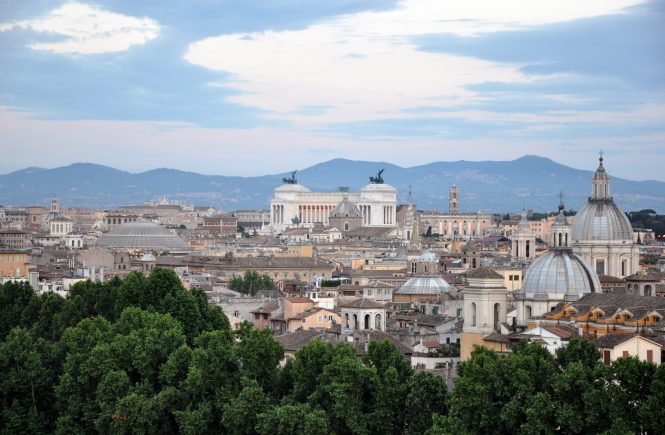
Looking for a gift for someone who loves food—especially Italian food? Then do them, and me, a favor: Don't get them a gift certificate to the Olive Garden or a gift basket of random, made-in-the-U.S. products that reflect little to nothing of Italian food culture.
These days, there's no reason to. Thank modern technology. Even if you're not in Italy, you can buy authentic, Italian foods—including cheeses, meats, pastas, coffees, and more—that make fantastic gifts for foodies and Italophiles alike.
Whether you're looking for a stocking stuffer, a single present, or some items to put together your own gift basket, here are some Italian food gift ideas to get you started.
(This is the first of a series of holiday gift guides I'll be publishing!).
Stocking stuffers for the sweet-toothed
 Of Italy's many kinds of Christmas cakes, panettone the most famous. Originally from Milan, it's studded with raisins and candied fruit peels. Although it's best to get it fresh from a local baker, you can get it online if you have to.
Of Italy's many kinds of Christmas cakes, panettone the most famous. Originally from Milan, it's studded with raisins and candied fruit peels. Although it's best to get it fresh from a local baker, you can get it online if you have to.
Baci chocolates are so well-known in Italy, "Baci" is a common gelato flavor. And no wonder: They're a blend of milk chocolate and ground hazelnutes (dubbed gianduia), crowned with a hazelnut and covered in dark chocolate. In other words… I'm not sure there's a chocolate lover in the world who wouldn't want to see this box under their tree. Unless they were allergic to nuts.
The Italian spread Nutella has become a worldwide sensation, and with reason: This creamy, hazelnut-and-chocolate spread goes on, well, almost anything. Including your finger, straight out of the jar. Top off the topping with The Unofficial Guide to Nutella, a fun, easy-to-read, and recipe-filled book by my friends Sara Rosso and Michelle Fabio.
Staples for anyone: Italian olive oil and balsamic vinegar
As any "foodie" knows, great food starts with great ingredients. And few staples are more important, whether you're cooking "Italian" or not, than a great olive oil or balsamic vinegar. Frankly, I don't like to cook. But if I just drizzle a little bit of a top-notch, extra-virgin olive oil (more on what that is in a moment) on pasta or a salad, somehow, I feel like I'm eating food whipped up by Mario Batali himself.
So, when it comes to olive oil, choose your oil carefully. Extra-virgin is a must, but that's not enough, since fraud is rampant in the olive oil industry. Seventy percent of extra-virgin olive oils sold worldwide aren't extra-virgin, in fact, but are cut with lower-grade oils.
Some trustworthy places to buy olive oil include the selection of Italian, imported oils at Zingerman's or the Corti Brothers (who also, by the way, have some other amazing-looking, authentic Italian food products).
My favorite extra-virgin olive oil, though, is produced by my friend Alina at Fontanaro, an organic agriturismo on the Tuscan-Umbrian border run by Alina and her mother. Their oil is rated as among the best in Italy by guides like Gambero Rosso and Slow Food; it's also organic, delicious, and can be shipped anywhere in the world. And the prices couldn't be more fair. Email alina@fontanaro.it for more info, or check out Cleo's Fine Oils and Vinegars, which sometimes has Fontanaro's oils in stock. (And yes: This is the olive oil I have on my counter right now).
Pick your balsamic vinegar of Modena carefully, as well; you always want to make sure it has the "D.O.P." label, which means that it was, in fact, created in Modena, using the right grapes, the right process, and meeting the right quality standards. (In the U.S., we can call anything "balsamic vinegar of Modena," even if it never touched Italy). The award-winning Vigna Oro Balsamic Vinegar di Modena DOP is a good bet.
For caffeine addicts
 Do right by the caffeine-lovers in your life. If you can't make it to Sant'Eustachio, the best spot for coffee in Rome, in person to scoop up some blends as a gift, you're still in luck: They now have blends available online. Pick from whole beans
Do right by the caffeine-lovers in your life. If you can't make it to Sant'Eustachio, the best spot for coffee in Rome, in person to scoop up some blends as a gift, you're still in luck: They now have blends available online. Pick from whole beans or
ground coffee.
And to really have coffee the Italian way, don't forget the espresso maker. These little contraptions are small, cheap, and long-lasting, and they're an integral part of Italy's coffee culture: I have yet to enter a single Italian kitchen that doesn't have at least one of these sitting on the stove (and no American filter-coffee machine in sight!).
For cheese and meat-lovers
Although it seems a little random (you're going to give someone meats and cheeses? really?), this can be a great gift. A couple of years ago, I made up a basket of cured meats I'd brought from Italy for my stepfather, a real guy's guy; he loved it (and, needless to say, it disappeared quickly).
Just remember that it's impossible to get cured meats, like prosciutto, as thinly-sliced as they would be at an Italian butcher. So to go a step beyond, consider giving an electric food slicer to go with that array of meats.
If you're not in Italy, and you can't find authentic, Italian meats and salamis at your local butcher (if you want the "real deal," always ask where they're sourced from), then check into ordering online. (As with all of these products, ensure that what you're buying is made in and shipped from Italy and, if applicable, protected by "D.O.P." or "I.G.P." status). Mortadella from Bologna might be where we got our "baloney" from, but yes, the real deal is a completely different (and tastier) story. For a less-known meat, speck from Alto Adige
is a lightly-smoked, dry-cured ham from the Tyrolean region of Italy . My favorite, though—and this is something that's in my kitchen here in Rome right now—is the delicious standby,
prosciutto di Parma.
 For cheese-lovers, an array of some of Italy's best cheeses can't go wrong. Some of my favorites include fontina from theValle d'Aosta,
For cheese-lovers, an array of some of Italy's best cheeses can't go wrong. Some of my favorites include fontina from theValle d'Aosta, Pecorino Romano from Rome, caciotta al tartufo from Umbria, ricotta salata from Sicily, and, of course, the two most famous guys: fresh mozzarella di bufala
from Campania (I promise, it's completely different than mozzarella back home) and Parmigiano Reggiano from Parma (also completely unlike that powdery stuff you get in the green cans in U.S. grocery stores). Yum!
Books for cooks
 This book hits shelves tomorrow, but it's already available for pre-order… and looks fantastic. The Encyclopedia of Italian Cooking, published by the editors of La Cucina Italiana magazine, features how-tos for every quintessential Italian cooking technique, from how to shape tortellini to how to recognize a San Marzano tomato. Some 500 recipes are included, too. A great gift for beginners to Italian cooking, or for those who want to brush up on their techniques.
This book hits shelves tomorrow, but it's already available for pre-order… and looks fantastic. The Encyclopedia of Italian Cooking, published by the editors of La Cucina Italiana magazine, features how-tos for every quintessential Italian cooking technique, from how to shape tortellini to how to recognize a San Marzano tomato. Some 500 recipes are included, too. A great gift for beginners to Italian cooking, or for those who want to brush up on their techniques.
(Another nice gift idea, of course, is a subscription to La Cucina Italiana magazine).

Or go for the bible of Italian country cooking.
La Cucina: The Regional Cooking of Italy
got its start 50 years ago, when Italian scholars gathered to figure out how they could preserve traditional, Italian cooking in the face of so much change. The Italian Academy of Cuisine did research in hundreds of villages, getting recipes right from people cooking in front of their stoves, and gathered these 2,000 recipes, which include arancini di riso from Sicily, buridda (fish stew) from Liguria, and everything in between.
For a cookbook of Italian recipes at their most authentic, check out the Essentials of Classic Italian Cooking
. Don't expect any spaghetti and meatball recipes here: Instead, there are fantastic treatments of classics like ossobucco, polenta, gnocchi, risotto, and more.
I love the idea behind the beautifully-photographed The Italian Farmer's Table: Authentic Recipes and Local Lore from Northern Italy
. It gathers 150 recipes taken directly from agriturismi in northern Italy. In other words, it doubles as a cookbook… and as inspiration for anyone planning on visiting northern Italy and wanting ideas of where to go, what to eat, and even what agriturismi to stay in!
For winos wine-lovers

Pair a bottle of excellent Italian wine with a little background reading for the recipient. One great place for wine-lovers to start is Vino Italiano: The Regional Wines of Italy, which covers Italy's wine-producing regions, identifies their most important wine styles, prodcuers, and vintages, and even includes recipes.
Wine Map of Italyis, literally, a map—and any wine-lover will want to have it as a reference at hand, or even tacked to their wall. It includes Italy's DOC, DOCG and IGT wine zones, plus an index booklet.
Gambero Rosso's Italian Wines has always been the number-one way to sort out Italy's best vintages, from the rest. The Italian Wines 2012version is a little different than past ones, but wine enthusiasts will still want to have it on their shelves.
For those who like reading about food (almost) as much as eating it
 How Italian Food Conquered the World is a great look at, well, how Italian food conquered the world—or, more accurately, how it transformed as it moved from Italy into immigrant communities abroad. I've written about the book before.
How Italian Food Conquered the World is a great look at, well, how Italian food conquered the world—or, more accurately, how it transformed as it moved from Italy into immigrant communities abroad. I've written about the book before.
Waverley Root's The Food of Italy is a classic; each chapter covers a different Italian region, with basics about the area's food culture and its most popular dishes.
Probably the most fun of all of these reads, Delizia!: The Epic History of the Italians and Their Food is a well-written, fast-paced history of Italy—told through its food, from Renaissance banqueting halls to 19th-century Naples alleyways.
Olive oil's history isn't just thousands of years long… it's also full of scandal—perhaps not so surprising in an industry that has as much money in it as hard drugs (!). This book, Extra Virginity: The Sublime and Scandalous World of Olive Oil, started as a New Yorker article, and it's on my bookshelf Kindle as we speak.
Liked this gift guide? Then make sure to check out the other ones I'll be posting soon!
https://dashboard.mediavine.com/sites/3126/edit




















